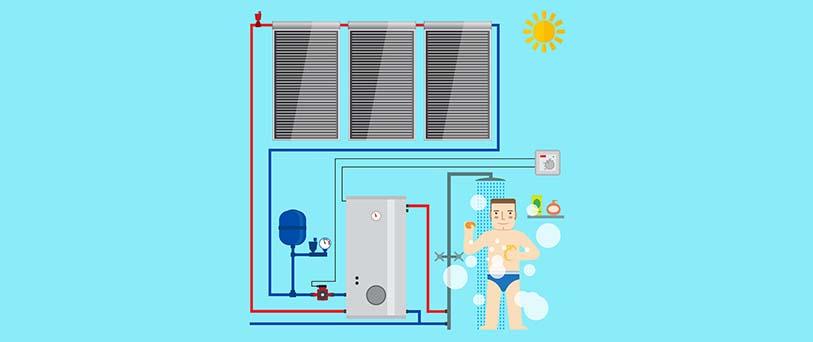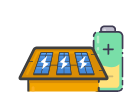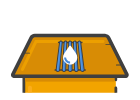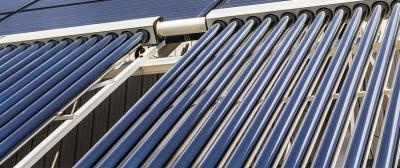Solar PV vs Solar Thermal

Solar PV panels generate electricity while a solar thermal system provides domestic hot water. Either of these solar systems will benefit your home in a number of ways but which is better suited to your home? We've put solar PV vs solar thermal head-to-head to weigh up the pros, cons and costs of each solar system.
Solar PV vs Solar Thermal
Depending on how you want to use solar energy, you'll need to decide between solar PV and solar thermal panels. While both convert solar energy into usable energy, the outcome differs. Solar photovoltaic (PV) panels generate electricity while solar thermal contributes to providing domestic hot water.
How do solar PV panels work?
Solar photovoltaic panels (PV) convert energy from the sun into electricity. Within the panels are solar cells which, when exposed to sunlight, produce direct current (DC) energy. To power the appliances in the home, this electricity must be converted to alternating current (AC) and this is done by a solar inverter. Once the renewable electricity has passed through the solar inverter, it's ready to power the electrical items around the home.
How do solar thermal panels work?
Solar thermal panels, which are made up of solar thermal collectors, are (usually) installed on the roof where they absorb energy from the sun. Rather than converting it into electricity, as solar PV panels do, the energy is used to produce heat water stored in a cylinder. This means that solar thermal panels are only a viable option if you have a heating system that includes a hot water cylinder.
Solar thermal collectors contain tubes of water which, when heated by the sun, can reach temperatures of up to 90°C. The heated liquid then passes through pipes down to the property's hot water cylinder. Within the cylinder is a coil which the liquid heated by the sun passes through to produce domestic hot water.
There are two types of solar thermal panel: flat plate collectors and evacuated tubes.
Flat plate collectors
Flat plate collectors most closely resemble solar PV panels as they're flat and dark in colour. Liquid is circulated around tubing which is heated by solar energy. Above this tubing is an absorber plate which helps to prevent heat from escaping
Evacuated tubes
Contrary to flat plate collectors, with evacuated tubes the pipes are completely visible. Glass panels sit in parallel lines each of which has an insulated absorber. There are two types of evacuated tube solar thermal panels:
- Direct Flow: fluid in the absorber flows through the pipes to the hot water cylinder
- Heat Pipes: fluid evaporates at a low temperature then rises up and condenses. The heat is transferred into the pipes and hot water cylinder before the fluid goes back to the solar thermal tubes where it is ready to be heated again
Solar PV vs Solar Thermal: What are the benefits?
Installing solar panels of any kind will be beneficial to your home. Rather than relying on an energy supplier, you will become much more self sufficient. And this will help to save you money on your energy bills, lower your carbon footprint and potentially increase the value of your property.
While solar pv and solar thermal panels share many benefits each have their own unique set of benefits too.
Benefits of solar PV
- Reduce reliance on your energy supplier and lower your electricity bills as a result
- Charge an electric vehicle
- Store excess energy in a solar battery and use it when the solar panels aren’t generating energy
- The generated electricity can be used to provide hot water via an immersion heater in a hot water cylinder
- Silent during operation
- No moving parts so require very little maintenance
- Straightforward installation that won't have as much interference as solar thermal
- Receive payments through the Smart Export Guarantee (SEG)
Benefits of solar thermal
- Potentially save up to 70% on domestic hot water
- Extremely low maintenance
- Will last for a between 20 and 25 years
- Potentially more affordable than solar PV depending on the size of the system
- Earn payments through the Renewable Heat Incentive (RHI)
Solar PV vs Solar Thermal: Considerations
Making an investment in solar energy comes with many benefits. However, it's important to weigh up the pros with the cons.
One of the main considerations with solar is that the sun isn't out all the time. This means that during the night you may have to rely on your energy supplier. And while this is certainly the case with solar thermal a solar battery be installed as part of a solar PV system to store excess electricity.
During the day, solar PV panels are likely to be generating more electricity than can be used. Without a solar battery, this energy would go to the National Grid. However, with a solar battery it becomes possible to use it yourself when the panels aren't generating electricity (in the evening and during the night).
A solar PV system can take up a large amount of space on the roof, depending on the system size needed to meet demand.
A solar thermal system is best installed as part of a renovation or during the construction of a property. This is because solar thermal panels must be connected to the plumbing. Solar thermal isn't able to provide round-the-clock hot water so a boiler or immersion heater will be needed to top-up the supply.
How solar PV systems can provide hot water
It's possible for excess electricity generated by solar panels to provide domestic hot water. The addition of a Solar iBoost can put any excess electricity generated by solar panels to use by redirecting it to an immersion heater in a cylinder.
Solar PV vs Solar Thermal: Comparing the costs
The cost of solar PV and solar thermal will vary depending on the size of the system, manufacturer and model. The size of a solar system will depend on the level of demand for either electricity or hot water.
As a guide, a 3 bedroom home with 3-4 occupants would require a 3-4 kW solar PV system or 3m2 – 4m2 solar thermal system. This would result in costs of £5,520 – £6,040 for solar PV and a slightly more affordable £3,100 – £4,200 for solar thermal.
| Solar PV System Size | Average Cost of Installation |
|---|---|
| 1 kW | £1,840 |
| 2 kW | £3,680 |
| 3 kW | £5,520 |
| 4 kW | £6,040 |
Solar thermal panels can cost between £2,500 and £5,400. It's possible to work out the size of the system needed with the number of people living in your home. For every occupant in the property, around 1m2 of additional solar thermal panels will be needed.
| Solar Thermal System Size | Occupants | Average Installation Cost |
|---|---|---|
| 2m2 | 2 | £2,500 - £3,000 |
| 3m2 | 3 | £3,100 - £3,600 |
| 4m2 | 4 | £3,700 - £4,200 |
| 5m2 | 5 | £4,300 - £4,800 |
| 6m2 | 6 | £4,900 - £5,400 |
Can solar PV panels be installed alongside solar thermal?
If you can't decide between solar PV and solar thermal, you could have both systems installed. This could either be as two separate systems or as a solar PV-T system. Solar PV-T is a photovoltaic and thermal system that's able to use solar energy to provide electricity and domestic hot water.
Solar PV-T systems aren't yet as popular as solar PV or solar thermal systems so it's important to find an installer with the relevant accreditations.
Solar PV vs solar thermal: Which should you choose?
An investment in solar energy, whether it’s through solar PV or solar thermal, is well worthwhile. You'll be reducing the reliance on your energy supplier and in turn seeing a reduction in your bills.
Out of the two, solar PV is the most flexible option. A solar PV system gives you the option to store energy in a solar battery and can also provide domestic hot water via a Solar iBoost.
For solar thermal panels to be installed, your heating system must include a hot water cylinder. So, if your home is heated by a combi boiler, and you want to invest in solar then it will have to be solar PV.
Ultimately, the decision comes down to which makes the most sense for your property. Homes with a hot water cylinder and high demand for domestic hot water would massively benefit from a solar thermal system. Meanwhile, if your electricity bills have been rising and you want to become more self-sufficient then solar PV is the right choice.
If you're still unsure, you could get the expert advice of an MCS accredited solar installer. With Solar Guide, you can get free quotes from up to 4 solar panel installers for the installation of solar PV or solar thermal. Comparing multiple quotes will increase your chances of getting the most competitive price for the installation. All you have to do is complete our simple online form, answering some straightforward questions about your property and the work involved.
Find local, MSC certified Solar Installers
Start your quote
Find local, MSC certified Solar Installers















